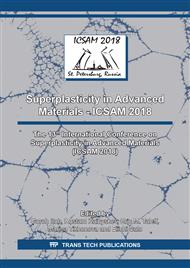p.419
p.424
p.430
p.437
p.443
p.449
p.455
p.461
p.468
Modification of the Shear-Compression Specimen and Development of a Special Technique for the Physical Simulation of Asymmetric Rolling with a Large Strain
Abstract:
Physical simulation of the stress-strain state and microstructure evolution, which are similar to that occurring during asymmetric rolling with a large strain, is very important for design of technologies of producing ultra fine grained metallic materials. This paper presents the results of optimization of specimen geometry and a special multi-cycle shear-compression technique for the physical simulation of asymmetric rolling with a large strain up to e ~ 4. The specimen consisted of a parallelepiped having an inclined gauge section created by two diametrically opposed semi-circular slots which were machined at 45°. The specimen was compressed between two flat dies during shear-compression testing in accordance to the special multi-cycle scheme. Each cycle of the shear-compression testing consisted of two steps. The first step included height reduction of specimen, after that specimen was rotated by 90º. The second step included length reduction of the specimen for getting the quasi original shape of a parallelepiped. The specimen provided simultaneous pure and simple shear in an inclined gauge-section. The level of effective strain was controlled through adjustment of the specimen geometry, height reduction, load application direction and number of cycles of shear-compression. Gauge thickness, width and radius of the specimen were optimized by FEM with using of software DEFORM 3D. Numerical simulation and comparison of the stress-strain state during shear-compression testing and asymmetric rolling of low-carbon steel AISI 1010 were performed. Results of FEM analysis of the applicability of the multi-cycle shear-compression testing to the modeling of asymmetric rolling were discussed.
Info:
Periodical:
Pages:
461-467
Citation:
Online since:
July 2018
Price:
Сopyright:
© 2018 Trans Tech Publications Ltd. All Rights Reserved
Share:
Citation:


